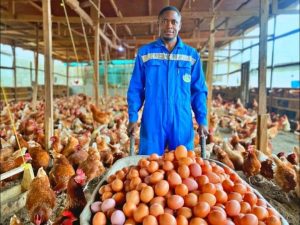The Lucrative Venture of Kienyeji Chicken Farming in Kenya: A Comprehensive Analysis

Kienyeji chicken farming has emerged as a highly profitable venture in Kenya, offering farmers the opportunity to generate significant income with relatively low investment. Business consultant Timothy Angwenyi and business mentor Justine Nyachieo have shared an in-depth personal analysis, revealing the financial benefits and practical strategies for successful Kienyeji chicken farming.
Starting with just 20 hens and 3 mature roosters (jogoos), farmers can potentially grow their flock to over 300 chickens by the end of the year. The key to this success lies in maintaining an optimal ratio of 1 jogoo to 7-10 hens, ensuring effective fertilization of eggs.
Step-by-Step Growth Strategy:
Initial Setup:
Purchase 20 hens ready to lay and 3 mature jogoos.
Ensure the ratio of males to females is maintained for optimal fertilization.
Egg Laying and Hatching Cycle:
Month 1: Hens start laying eggs.
Month 2: Eggs hatch.
Month 3: Hens rear their chicks. Withdraw the mother hen at the end of this month to force her to start laying again.
Month 4: Hens take a laying break.
Month 5: Hens start laying again.
Month 6: Eggs hatch.
Month 7: Hens rear their chicks. Withdraw the mother hen at the end of this month.
Month 8: Hens take a laying break.
Month 9: Hens start laying again.
Month 10: Eggs hatch.
Month 11: Hens rear their chicks. Withdraw the mother hen at the end of this month.
Month 12: Hens take a laying break, ready to start over in the new year.
Important Considerations:
Egg Management: Limit each hen to hatch 8 eggs to ensure a higher success rate.
Chick Rearing: Protect chicks from predators and manage them in a closed environment for the first month.
Hen Longevity: Each hen can go through this cycle up to 5 times before their productivity decreases.
Space Management: Use paddocks to manage different ages and maintain a floor stock of 300 hens and 50 jogoos for easier management.
Financial Projections:
From 20 hens, each laying 15 eggs and hatching 8, farmers can achieve three cycles per year, resulting in approximately 300 new hens annually.
With a 50/50 ratio of cocks to hens, farmers can sell 100 mature jogoos in markets such as Nairobi, significantly boosting income.
Additional revenue comes from selling eggs not used for hatching. Selling 3,500 eggs every four months at Ksh.15 per egg totals Ksh.52,000.
Selling 500 hens, 250 jogoos, and 250 immature hens (mweras) at an average price of Ksh.500 each results in Ksh.500,000 per year.
Combined with egg sales, total annual revenue can reach Ksh.656,000.
Considering a 25% budget for expenses, farmers can pocket approximately Ksh.492,000 annually, averaging Ksh.41,000 per month.
Conclusion:
Kienyeji chicken farming offers a sustainable and profitable agricultural venture for Kenyans. By following the outlined strategies and maintaining dedicated management, farmers can enjoy substantial returns while having more time for family and personal pursuits. This venture not only boosts income but also contributes to food security and economic growth in Kenya.








